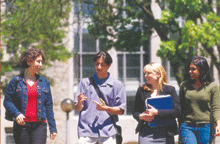After three decades of increases at more than double the rate of inflation, the cost of attending an American private university has reached a politically unpalatable new high. This autumn, one year of tuition, room and board and mandatory fees will surpass the US annual median household income of $48,023 (Rs.22 lakh).
 It is a milestone the universities may have hoped would pass without notice. But a backlash appears to be looming against a sector long insulated from the need to cut costs by the fact that demand for higher education in the US, except at the lowest-ranked institutions, such as state and community colleges, has consistently exceeded supply. Elite private universities, and even some public institutions, accept as few as one in ten applicants. “At some point we (will) get to a threshold of anger that will force something to happen,” says Richard Vedder, distinguished professor of economics at Ohio University, a public higher education institution. “We’re not quite there. But we’re getting closer.”
It is a milestone the universities may have hoped would pass without notice. But a backlash appears to be looming against a sector long insulated from the need to cut costs by the fact that demand for higher education in the US, except at the lowest-ranked institutions, such as state and community colleges, has consistently exceeded supply. Elite private universities, and even some public institutions, accept as few as one in ten applicants. “At some point we (will) get to a threshold of anger that will force something to happen,” says Richard Vedder, distinguished professor of economics at Ohio University, a public higher education institution. “We’re not quite there. But we’re getting closer.”
And it is not only private universities, including the Ivy League institutions, which are in the frame. The rate of increase in charges at many public universities has been just as high — and in some cases even higher — because their previous main source of support — state government allocations — has fallen.
Legislators, who oversee public universities, want accountability. And both private and public universities, their critics say, are paying dangerously scant attention to the tide that is rising against them. Since 1988, the average cost of an undergraduate degree at public and private US universities has risen by 375 percent, far faster than the 127 percent increase in median family income in the same period. Simultaneously the economic advantage enjoyed by graduates is weakening.
“A college education still gets you more (money) than not having one, but it hasn’t been rising lately,” says Jared Bernstein, a researcher at the Economic Policy Institute, a non- partisan think-tank. Since 2000, the average wage has risen only 2.5 percent in real terms, he adds. “Tuition goes up that much every 20 minutes.”
The number of administrative staff in US universities has tripled in the past three decades. And for 11 years in a row they have received salary increases above the rate of inflation. Presidents of elite private universities and even those of some public institutions now receive an average of close to half a million dollars a year, plus free housing, expense accounts and generous benefits. Both public and private universities are exempt from income tax, while donors benefit from deductions allowed for charitable giving.
Secretary of education Margaret Spellings warned higher education officials in July that, if universities do not change, change will be imposed. “In the absence of continued leadership in education, others will step in,” she says.
Universities, say some observers, have an emotive trump card: parents’ desire to find ways to pay for their children to go to the university of their choice. “Colleges play on people’s emotions,” says Dr. Vedder author of Going Broke by Degree: Why College Costs too Much and a member of the Spellings Commission. “Parents will do anything for their children. And universities are wonderfully adept at tapping into these emotions.”
Excerpted and adapted from The Times Higher Education Supplement